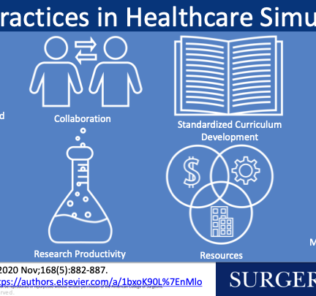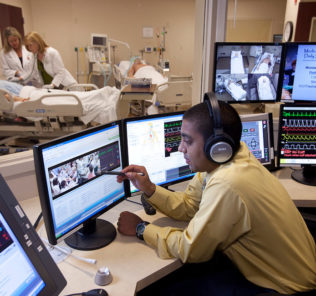New INACSL Healthcare Simulation Standard of Best Practice: Professional Development
Developing a set of best practices can help any healthcare simulation flourish, as these guidelines help promote successful learning and training outcomes. For example, the INACSL Standards of Best Practice provide an excellent guide to all aspects of clinical simulation and are applicable to everyone involved in any level of medical education. Recently, the organization’s best practices have been revamped to reflect the ever-evolving science that is clinical simulation. This article highlights the INACSL Standards Committee’s latest version of the “Healthcare Simulation Standards of Best Practice Professional Development.
INACSL begins these recommendations by explaining that the early development of simulation-based education was largely provided by equipment managers. Now, more attention is being paid to the “pedagogy underlying the practice.” Further, a more participant-centered and evidence-based approach has helped the field mature as a whole. This progression is what ultimately has led to the need for professional standards and the recognition by regulatory bodies that simulation – necessary for continued professional development.
Through the publication of these guiding criteria, professionals can more easily set expectations for individuals and simulation programs to demonstrate adherence to professional SBE standards. Although roles and responsibilities vary from institution to institution, based on organizational resources and the previous experience, knowledge, and skills of the simulationist, all professional development standards provide a roadmap. Specifically, INACSL’s best practices include three criteria to meet the standard, all of which are explained below.
Sponsored Content:
Criteria Necessary to Meet this Standard
- Perform an educational needs assessment that includes a gap analysis to provide the foundational evidence for a well-designed professional development plan.
- Participate in professional development activities that address desired learning outcomes and align with an individual’s role and the priorities of the institution.
- Reevaluate the professional development plan on a regular basis using formative and summative methods by both the individual and the organization.
Criterion 1: Perform an educational needs assessment for each individual that includes a gap analysis to provide the foundational evidence for a well-designed professional development plan.
Required Elements:
- Develop the educational needs assessment utilizing formative and summative assessment of the individual’s skill set based on educational standards, review of professional literature, current practices, and organizational needs. This should include self-reflection, assessment of current knowledge, and future goals.
- Identify gaps based on recognized resources, including, but not limited to: Healthcare Simulation Standards of Best PracticeTM, Certified Healthcare Simulation Educator (CHSE) Standards, If Society of Simulation and Healthcare (SSH) Accreditation Standards, Association for Standardized Patient Educators (ASPE) Standards, Association for Simulated Practice in Healthcare (ASPiH Standards), National Organization of Nurse Practitioner Faculties (NOPF), the Canadian Certified Simulation Nurse Educators competencies (CASN).
Criterion 2: Participate in professional development activities that address learning outcomes and align with an individual’s role and the priorities of the institution.
Sponsored Content:
Required Elements:
- Pursue professional development based on identified learning outcomes.
- Incorporate current best practices found in the literature into daily practice.
- Contribute to the body of knowledge in simulation (e.g., publications, editorials, empirical research, blogs, social media, and presentations).
- Integrate standards from professional organizations (e.g. Healthcare Simulation Standards of Best PracticeTM, CHSE Standards, SSH Accreditation Standards, APSE Standards, ASPiH Standards, National Organization of Nurse Practitioner Faculties (NOPF), CASN Standards, and Healthcare Simulation Dictionary.
- Attend and contribute to healthcare simulation conferences at the local, regional, national, and international levels.
- Partner with colleagues in the field to present a session, poster or workshop.
- Develop and lead a session, poster, or workshop.
- Develop a community of practice at the local, regional, national, and international levels.
- Foster peer relationships within the field of healthcare simulation.
- Engage with simulation experts who can serve as mentors, provide feedback, and contribute to continuous professional growth.
- Incorporate peer review and mentoring as a developmental strategy.
- Explore opportunities to collaborate with others in the field of simulation.
- Develop mentorship skills and foster the growth of others in simulation.
- Pursue professional certification through simulation organizations.
- Participate in formal education programs in healthcare simulation such as certificates, academic degrees, and fellowships.
- Ensure the organization supports the development of an actionable professional development plan that aligns with the individual’s role and the priorities of the institution.
HealthySimulation.com Clinical Simulation Resources:
- LEARN: The New Home for Healthcare Simulation Webinars & Courses!
- Healthcare Simulation Conferences & Workshops
- Healthcare Simulation Books
- Healthcare Simulation Research Journals
- Coronavirus COVID-19 Medical Simulation Resources List
Criterion 3: Reevaluate the professional development plan on a regular basis using formative and summative methods by both the individual and the organization.
Required Elements:
- Simulation professionals should commit to continued professional growth through reflection on current knowledge, skills, and abilities, and review of professional literature, current practices, and organizational needs.
- Resources for reevaluation and goal setting may include: Healthcare Simulation Standards of Best PracticeTM, CHSE Standards, SSH Accreditation Standards, APSE Standards, ASPiH Standards, National Organization of Nurse Practitioner Faculties (NOPF), CASN Standards, and Healthcare Simulation Dictionary.
Learn More About INACSL
INACSL’s mission is to advance the science of nursing simulation by providing worldwide professional development, networking resources, and leadership in defining healthcare simulation standards of best practice. Formally naming itself INACSL or the International Nursing Association for Clinical Simulation and Learning in 2002, the organization has grown from an all-volunteer organization based in Texas to a worldwide resource with over 2500 members. INACSL educational materials and resources can be used for anyone.
INACSL holds an annual four-day conference every June in various centers around the United States and Canada. The conference focus is mostly geared towards Nursing Education at the undergraduate and graduate levels. Hospital education departments could also benefit from conference attendance. These events provide education sessions, research results, networking opportunities, and vendor exhibits for leading companies such as Laerdal, CAE Healthcare, SimulationIQ, Gaumard, B-Line Medical, KBPort, Pocket Nurse, 3D Systems, and more.
In addition, INACSL provides webinars, leadership book clubs, and journal roundtables in a virtual format.
Here’s the latest message from INACSL President Suzan Kardong-Edgren PhD, RN, ANEF, CHSE, FSSH, FAAN
INACSL is accredited as a provider of continuing nursing education by the American Nurses Credentialing Center’s Commission on Accreditation. In addition to the standards of best practice, INACSL offers other online resources including homegrown solutions links, a bibliography of simulation articles, and resources for researchers. INACSL publishes the journal Clinical Simulation in Nursing with Dr. Nicole Harder as the current Editor-in-Chief.
Learn More About INACSL Standards of Best Practice
Lance Baily, BA, EMT-B, is the Founder & CEO of HealthySimulation.com, which he started while serving as the Director of the Nevada System of Higher Education’s Clinical Simulation Center of Las Vegas back in 2010. Lance is also the Founder and acting Advisor to the Board of SimGHOSTS.org, the world’s only non-profit organization dedicated to supporting professionals operating healthcare simulation technologies. His co-edited Book: “Comprehensive Healthcare Simulation: Operations, Technology, and Innovative Practice” is cited as a key source for professional certification in the industry. Lance’s background also includes serving as a Simulation Technology Specialist for the LA Community College District, EMS fire fighting, Hollywood movie production, rescue diving, and global travel. He and his wife Abigail Baily, PhD live in Las Vegas, Nevada with their two amazing daughters.
Sponsored Content:


















